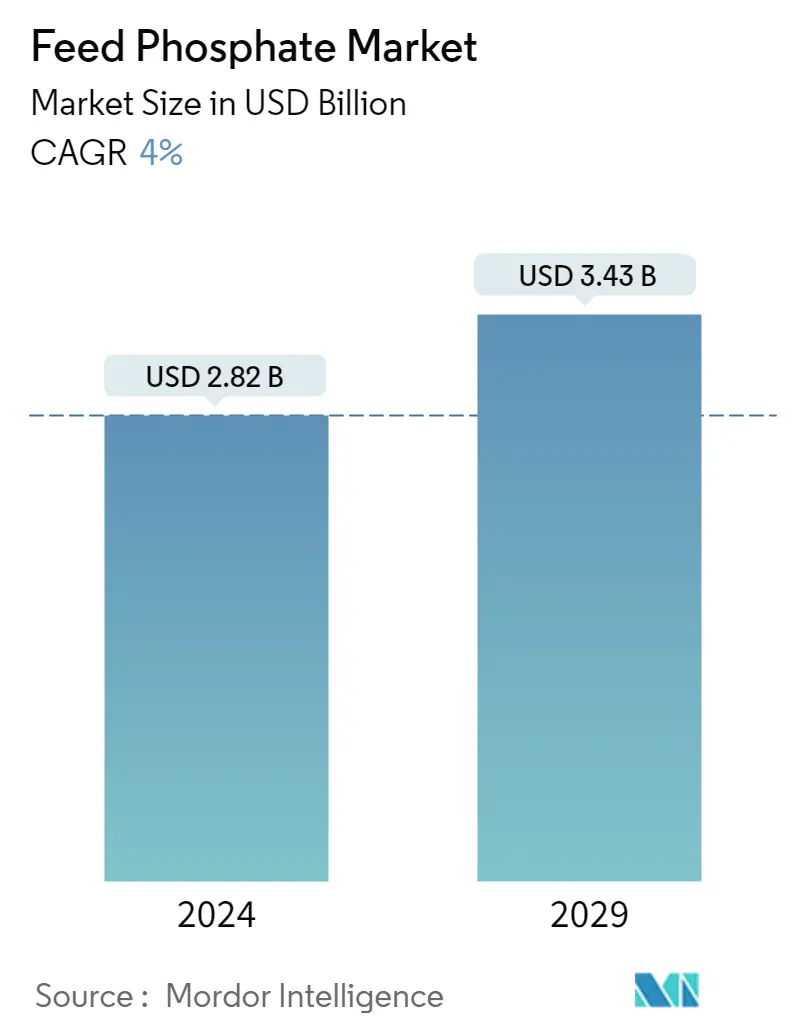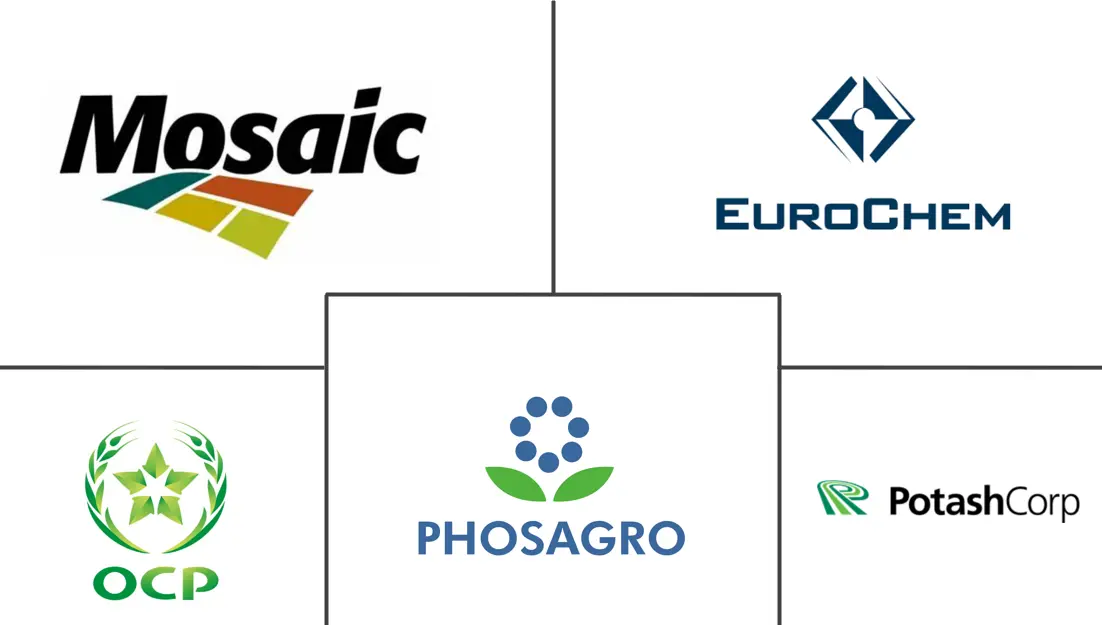Market Size of Feed Phosphate Industry

| Study Period | 2019 - 2029 |
| Market Size (2024) | USD 2.82 Billion |
| Market Size (2029) | USD 3.43 Billion |
| CAGR (2024 - 2029) | 4.00 % |
| Fastest Growing Market | North America |
| Largest Market | Asia-Pacific |
| Market Concentration | Medium |
Major Players
*Disclaimer: Major Players sorted in no particular order |
Feed Phosphate Market Analysis
The Feed Phosphate Market size is estimated at USD 2.82 billion in 2024, and is expected to reach USD 3.43 billion by 2029, growing at a CAGR of 4% during the forecast period (2024-2029).
- The main driving factor is the growing consumption of meat worldwide. Poultry meat consumption increased by 76.6% per kilo per capita, and pig meat by 19.7% in 2021. According to the Organisation for Economic Co-operation and Development (OECD) report 2022, poultry meat is expected to represent 41% of all the protein from meat sources in 2030, an increase of 2 percentage points when compared to the base period. The global shares of other meat products are lower: beef (20%), pigmeat (34%), and sheep meat (5%).
- The major leap in consumption is mainly by the middle-class population due to increasing disposable income. Livestock development by government organizations helped promote animal husbandry among the population, especially among the poorer sections, by emphasizing the importance of animal nutrition in animal welfare. Industrialization of the meat industry, specifically the poultry and pork segments, has been an important contributor to the feed phosphate industry, with rapid growth in lean meat consumption due to increased awareness of its health benefits.
- The rising cost of raw materials and the global scarcity of phosphate reserves, as it is a non-renewable resource, are restraining the market. Opportunities that affect the dynamics of this industry include increasing demand for natural feed products and substitutes, such as phytase being used in the manufacture of animal feed as blends to decrease the high cost of manufacture. Many companies also invested in R&D for the sustainable use of phosphate. Livestock production has increased globally and across all animal species to meet the demands of the population's shifting dietary habits, especially in developing markets.
- Even though the livestock industry is becoming more industrialized worldwide, particularly in Asia-Pacific, many farmers in nations like India and China are still marginal. Asia-Pacific is the world's largest producer and consumer of animal feed, and as a result, it directly affects the market for feed phosphates. The region's largest economies, including China and India, have increased their feed production capacities partly due to the region's expanding livestock industry.
Feed Phosphate Industry Segmentation
Feed phosphates are added to animal feed to improve the nutrient content, optimize animal performance, and enhance feed digestibility and health maintenance. They also help promote growth during the various stages of the life cycle, developing fertility in animals, and act as the best calcium source for bone and skeleton development.
The feed phosphate market is segmented by feed type into monocalcium phosphate, dicalcium phosphate, mono-dicalcium phosphate, tricalcium phosphate, defluorinated phosphate, and other feed types, livestock type into poultry, swine, cattle, aquatic animals, and other livestock types, and geography into North America, Europe, Asia-Pacific, South America, and Africa.
The report offers market size and forecasts in value (USD million) and volume (thousand metric ton) for all the above segments.
| Feed Type | |
| Monocalcium Phosphate | |
| Dicalcium Phosphate | |
| Mono-Dicalcium Phosphate | |
| Tricalcium Phosphate | |
| Defluorinated Phosphate | |
| Other Feed Types |
| Livestock Type | |
| Poultry | |
| Swine | |
| Cattle | |
| Aquatic Animals | |
| Other Livestock Types |
| Geography | ||||||||
| ||||||||
| ||||||||
| ||||||||
| ||||||||
|
Feed Phosphate Market Size Summary
The feed phosphate market is poised for steady growth, driven primarily by the increasing global demand for meat, particularly poultry and pig meat. This surge in meat consumption is largely attributed to the rising middle-class population with higher disposable incomes, which has spurred industrialization in the meat industry. The Asia-Pacific region, being the largest producer and consumer of animal feed, plays a pivotal role in this market's expansion. Countries like China and India are enhancing their feed production capacities to meet the growing livestock industry demands. However, the market faces challenges such as the rising cost of raw materials and the scarcity of phosphate reserves, a non-renewable resource. Despite these challenges, opportunities exist in the form of natural feed products and sustainable phosphate use, which are being explored through significant investments in research and development.
The feed phosphate market is moderately consolidated, with key players like The Mosaic Company, Eurochem, Potash Corp, PhosAgro, and OCP Group holding substantial market shares. These companies are actively expanding their operations through mergers, acquisitions, and product innovations to increase their global footprint. Recent developments include the launch of innovative phosphate products and strategic acquisitions to boost production capacities. The market's growth is further supported by the increasing demand for compound feed, which enhances meat quality and nutritional value, particularly in developing regions. As the livestock industry continues to industrialize, the demand for high-quality feed additives is expected to rise, further propelling the feed phosphate market's expansion during the forecast period.
Feed Phosphate Market Size - Table of Contents
-
1. MARKET DYNAMICS
-
1.1 Market Overview
-
1.2 Market Drivers
-
1.3 Market Restraints
-
1.4 Porter's Five Forces Analysis
-
1.4.1 Bargaining Power of Suppliers
-
1.4.2 Bargaining Power of Buyers
-
1.4.3 Threat of New Entrants
-
1.4.4 Threat of Substitute Products
-
1.4.5 Intensity of Competitive Rivalry
-
-
-
2. MARKET SEGMENTATION
-
2.1 Feed Type
-
2.1.1 Monocalcium Phosphate
-
2.1.2 Dicalcium Phosphate
-
2.1.3 Mono-Dicalcium Phosphate
-
2.1.4 Tricalcium Phosphate
-
2.1.5 Defluorinated Phosphate
-
2.1.6 Other Feed Types
-
-
2.2 Livestock Type
-
2.2.1 Poultry
-
2.2.2 Swine
-
2.2.3 Cattle
-
2.2.4 Aquatic Animals
-
2.2.5 Other Livestock Types
-
-
2.3 Geography
-
2.3.1 North America
-
2.3.1.1 United States
-
2.3.1.2 Canada
-
2.3.1.3 Mexico
-
2.3.1.4 Rest of North America
-
-
2.3.2 Europe
-
2.3.2.1 Germany
-
2.3.2.2 United Kingdom
-
2.3.2.3 France
-
2.3.2.4 Russia
-
2.3.2.5 Spain
-
2.3.2.6 Rest of Europe
-
-
2.3.3 Asia-Pacific
-
2.3.3.1 India
-
2.3.3.2 China
-
2.3.3.3 Japan
-
2.3.3.4 Australia
-
2.3.3.5 Rest of Asia-Pacific
-
-
2.3.4 South America
-
2.3.4.1 Brazil
-
2.3.4.2 Argentina
-
2.3.4.3 Rest of South America
-
-
2.3.5 Africa
-
2.3.5.1 South Africa
-
2.3.5.2 Rest of Africa
-
-
-
Feed Phosphate Market Size FAQs
How big is the Feed Phosphate Market?
The Feed Phosphate Market size is expected to reach USD 2.82 billion in 2024 and grow at a CAGR of 4% to reach USD 3.43 billion by 2029.
What is the current Feed Phosphate Market size?
In 2024, the Feed Phosphate Market size is expected to reach USD 2.82 billion.

